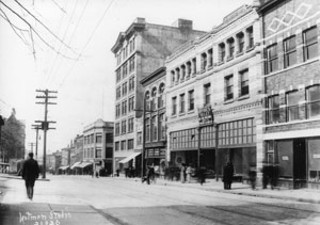It’s the first Wednesday morning in April and a white truck is parked on Barrington. The truck itself is pretty unremarkable---until a couple of men emerge from the storefront it’s parked beside carrying boxes stuffed with plastic shelving units. Then the vehicle’s purpose becomes clear. Just four days before, the retail space the men are leaving was still home to The Book Room. The movers place their boxes into the truck without ceremony. No one stops to play a bugle, or give a speech and neither of them look very sorrowful. The job they’re completing is probably just one task in a day chock full of them. The woman standing in the store’s doorway watching them has her hands on her hips. Maybe she doesn’t like the way the moving job is going, maybe she’s sad, maybe that’s just how she stands. After a moment she goes back into the empty storefront, locking the door behind her. The sign above the door still reads “Canada’s oldest bookstore.” It, too, will soon be gone.
While talks are apparently in the works, a new tenant for the space has yet to be found.
Across the street and a few doors down, the Freemasons’ building boasts its own new void. The storefront that for 12 years was home to vintage boutique Junk & Foibles (a 29-year-veteran of the downtown core) has hand-cut orange construction paper letters taped up in its window. “So Long,” they read. They’re accompanied by a smattering of red hearts. It makes me wonder whether the staff planned the display ahead of time, or whether the words were an afterthought---letters cut on a whim and taped in the window on the way out the door. Whatever their history, by the following Sunday the letters have been taken down. Only the paper hearts are left.
The store closures are the two latest on a street that’s gradually beginning to look more and more left behind. Up the street, at 1656 Barrington, the old Sam the Record Man space, vacant since its abrupt closure last February, is heartbreakingly devoid of CDs. While all signs indicate the building was recently sold, a new owner for the space hasn’t been announced. (The sale of the building to a local developer was scheduled to finalize March 31. Dan Sangster, of realtor JJ Barnicke Atlantic Limited which handled the sale, is unable to confirm whetherthe sale went through, but the “For Sale” sign in the window was taken down early this month.)
Meanwhile, across the way, the former Dooly’s space in the Roy Building has been vacant for about a year and the Starfish Properties paper in the building’s ground-level windows taunts us with its cute starfish-shaped blotches and lack of concrete information about what the company’s plans for the space might be.
Unsurprisingly, all these empty spaces and papered-over windows evoke unease about Barrington’s current health as a street. They certainly look like cause for concern. Which, of course, raises the question that Haligonians have been asking for decades---ever since the 1960s, when the street, once a focal point for city activity and commerce, began to slip in popularity as mall culture sprung up in the suburbs and businesses slowly began trickling away: Is Barrington in trouble?
Store owner Jeremy Smith doesn’t think it is. “There are no issues with Barrington,” he says. “I think it’s just the natural turnaround of the street.”
Granted, Smith, along with his wife, Erin, owns popular candy store Freak Lunchbox (opened in 2001) and the nearby Peepshow Girly Boutique (opened in 2005), two of Barrington’s most successful businesses. But that’s just the point, he says. “I think my businesses should be an indication that there’s nothing to fear on Barrington.”
Neither shop has seen any decline in business, even with the spate of Barrington store closures in the last year, Smith adds. In fact, “Freak is actually a little busier.”
Most of the people I speak with agree with at least one of Smith’s points. His stores---particularly Freak Lunchbox---are working. “They’re the coolest candy store in Halifax,” says Junk & Foibles owner Sarah Dunsworth. Since her business is one of the street’s recent closures, Dunsworth is more disappointed than Smith about Barrington and its failure to be a unique and livelybusiness district. But she says Freak Lunchbox is “one of the things that’s been helpful for Barrington.
“Everybody wants to walk downhere---stroll down Barrington to get toFreak Lunchbox.”
Opinion-wise, Smith has yet another surprise up his sleeve. He thinks the empty Dooly’s space in the Roy Building is positive for the street. “In combination with the Sam the Record Man , it kind of hurts public perception. But I think the opportunity to let a big retailer in there---is a good thing,” he says.
Of course, Smith has an inkling of the magic that could soon be happening behind those starfish-bespeckled window papers in the Roy Building. His landlord for the Peepshow Girly Boutique is Starfish Properties director (and Roy Building owner)Louis Reznick.
Historically, Reznick and his company have been kind to Barrington. They take care of their buildings. Reznick is responsible for a hefty renovation to the building that houses Peepshow and the Atlantic branch of Telefilm Canada. The outside of the building was shined up and Gyprock walls inside were stripped away. The project was helmed by David Garrett, a local architect whose name tends to pop up when the subject of Barrington revitalization is being discussed. (In 1998, Garrett was one of the key consultants for a report compiled for the municipality, province and Downtown Halifax Business Commission, entitled Downtown Barrington: A Strategy for the Rejuvenation of Barrington Street Halifax.)
“ really looks after his buildings and really spends the money that is needed, that’s required,” says Suzanne Saul, co-owner of contemporary furniture store Attica Furnishings, another of Barrington’s more recent business success stories and housed in another Starfish property. The store, which moved to Barrington from Granville the summer before last, expanded thispast December.
Attica, and the building that it is in (1566 Barrington), are often mentioned when people ask what’s currently working about Barrington Street. They’re cited as proof the street’s not all empty storefronts and neglected facades. But back in 1998, when the Garrett report was released, the building wasn’t impressing Garrett and his research team. “At present, the building is unoccupied and in a deteriorating state,” says the report. “Some of its upper windows are open to the elements.”
The building’s new life is the result of another Starfish Properties-commissioned renovation, aimed at preparing the space for then-tenant UpCountry. Among the improvements made during the project was a restoration of the building’s originalfrontage. Brickwork was chipped back toreveal the fancy pillars that now flank Attica’s entrance.
By all accounts, the Roy Building’s on its way to a similar rejuvenation. Moreover, the ground level of the building wasn’t vacated by a failing business actively fleeing Barrington. Reznick chose not to let Dooly’s renew its lease because he wanted to renovate and find a different kind of tenant for the building. That’s Smith’s assessment of the situation: “He’ll let sit empty until the end of time until he finds the right tenant.” That’s also what Downtown Halifax Business Commission executive director Paul MacKinnon says is going on---that the Roy Building’s being prepped for a “massive renovation.” Local representatives of Starfish chose not to be interviewed and Reznick, based in Toronto, prefers not to be interviewed by phone.
“He purchased the building with plans in mind,” says MacKinnon about Reznick’s Roy Building acquisition. “It could go to a single tenant, which would be very impressive. It could be broken up---I think he’s looking at a number of different options.” However, as far as MacKinnon knows, Starfish is looking to put retail in the building’s ground floor.
All this, of course, is the same information that those familiar with the project provided when approached by The Coast’s Shoptalk column last July, and it’s unclear whether much progress has been made with the property since. Moreover, shoppers ambling up Barrington don’t see any indication of the building’s potentially exciting future. They see an empty building and blue window-papers. Some of the drunker amblers even see a convenient place to relieve themselves. Impatient urinators have been known to drop trou in the Roy Building’s doorway.
The delay in the announcement of plans for the space---and a similar lack of information about the Sam the Record Man storefront’s future---have contributed to public worry about the street, MacKinnon concedes. “The regular customer is just going to see the boarded-up windows,” he says. “There’s no reason why they would know some of the story behind it.”
Part of the hold-up with the process could be the same thing that’s delaying many other promised refurbishments on the street, including the restoration of the fire-ravaged former National Film Board building (beside Attica). Building owners are waiting to see what happens with the infamous Barrington Street Historic District plan which, if approved in its current state, will provide tax credits and grants to Barrington owners who restore their buildings in accordance with certain preservation guidelines.
HRM heritage planner Bill Plaskett, one of the members of the historic district steering committee, says as far as he knows, the Roy Building renovations are one of several upgrades to the street “poised to take place” when and if the historic district plan is approved by council. Similarly, David Garrett, who says he “likely will be involved” with Roy Building renovations when they begin, adds that a start date for the project has to be decided, but that Reznick “hopes it will be in the very near future, particularly if the Barrington Street heritage district is approved and the incentives for redevelopment are included in that plan.”
Like Barrington’s decline, the plan to designate Barrington a historic district is one of those subjects people have been discussing for ages. “People have been talking about itfor 15 years or more,” says Plaskett. “And the conditions have never been quite right to get the level of buy-in that’s been needed.”
The “financial incentive” part of the four-part Barrington Street Historic District plan was approved in principle by council last month. The plan, now tied in with the overarching HRM by Design downtown plan, is currently the subject of public consultation and could be adopted by council as early as July. It’s the closest that all the talk about a historic district has come to being made concrete, and both Plaskett and MacKinnon are optimistic the plan will go through.
If it does, the renewed private and public reinvestment in Barrington that follows should go a long way toward quieting pesky concerns about the street being in trouble. Projects long in stasis, such as the old NFB site’s redevelopment, will finally start happening. The former NFB building was struck by fire in 1991 and its front was restored by the former city of Halifax in 1997, but its interior has remained untouched since. Chris Tzaneteas, one of the property’s owners, says he and co-owner Costa Elles plan to turn the property into a “mixed commercial and residential” development. They’re just waiting to see what kind of grants and tax credits will be available to help finance the costly refurbishment.
The general consensus among Barrington shopowners is that municipal investment in the street is long overdue. The street’s not living up to its potential and most say dedicated municipal or provincial interest in the street would improve the situation. “Tonnes of people have tonnes of great ideas. Maybe the city should listen to us, instead of wasting all their time thinking about cats,” says Dunsworth.
Saul says: “We have a lot of representation from council outside of the city core---and I don’t think they understand the needs of the downtown.” And the notion that the street has experienced some decline in the last year isn’t entirely an illusion. Dunsworth cites a recent drop in business at Junk & Foibles as a major reason her family decided to close the Barrington mainstay (the Freemasons’ building was also sold). John Doull, owner of used-book treasure-trove John W. Doull Bookseller, a much-loved store on the street, says his own business has been dropping steadily since the year 2000. “I can’t say I’ve seen it worse,” says Doull, about the street’s current condition, adding, “If people still want to have this kind of business here, they have to support it.”
That said, many think the street is in a better position than it has been in the past. “Well, you know, it’s funny: When we moved into Barrington Street it was empty,” says Shelley Taylor, owner of Venus Envy, who moved her store to the street from Inglisnine years ago. “And so, what I’ve seen is a real improvement of Barrington Street.” She, too, cites Attica’s move and the presence of Freak Lunchbox as factors improving the street’s health.
What remains to be seen is whether the street’s relative prosperity will continue; whether Barrington will attract and court more of the unique businesses that appear to have kept it afloat; whether all the high-minded plans for the street will at last stop being theoretical pipedreams; whetherwe’ll ever see that skating rink built inGrand Parade.
Sure, talking about reviving Barrington is inspiring. But wouldn’t it be fun to finallydo it?

















